Best Way to Gauge Long Range Shots
Many experienced hunters and long range precision shooters have multitude ways of determining the distance of long range shots. Ranging from eyeing it and seeing the effects or using math calculation on the scopes are all good. Here’s a method used by Chuck Tarinelli (Onehorse), follow along with his excellent illustrations and images to help you see the picture of your target from various distances. The following is Chuck’s explanation:
For making accurate shots beyond point-blank range, there are two things the hunter must be able to do. The first is to know precisely where your rifle bullet will hit at the longer ranges, and the second is to be fairly accurate at judging the distance at which the shot will be taken. If you can’t do BOTH of those things when you are looking through your scope at an animal – DON’T SHOOT!
Shooting Journal
At the range, it’s easy to practice shooting at various long distances. Most ranges have back stops at hundred yard intervals, or , if you have your own area in which to shoot, set these up for yourself. Please don’t only shoot at 100 yards and then, after simply reading a book about bullet drop, decide that you know where to aim at these longer ranges. Trust me, there is a BIG difference between studying long range shooting and actually doing it! As you do this shooting, be sure to record (write it down) exactly how much your bullet drops at these ranges and how far above the desired point of impact you need to hold at each of these distances. That way, when you see an animal at 200, 300 or 400 yards, you will know what your hold-over needs to be. But, of course, you need to know just how far away that critter is for this to work.
Cheap Range Finder
When I started hunting over forty-five years ago, my buddies and I didn’t get dozens of catalogs each year from “The World’s Foremost Outfitter” or anyone else, so we pretty much had to design and build much of our equipment. Even now, I prefer to devise my own gadgets whenever I can. Here’s a workable, effective and fun method for determining how far away an animal is from you that only requires an investment of about $3.00 for materials.
For starters, you need to know how many inches it is from back-line to brisket on the particular animal that you are hunting. On a bull elk that’s about 33 inches (give or take an inch or two), on a buck deer or ram it’s about 18 inches, and an adult antelope measures around 15 -16 inches.
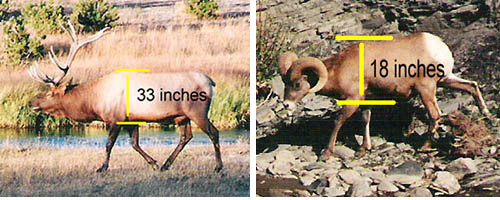
With those measurements (or those of the animal you are hunting) in mind, construct a ranging-target of the same size. This can be done by spraying an appropriate size rectangle of black paint on a piece of cardboard. Outline the rectangle with two inch wide white duct tape so that it has a nice sharp edge. (This is important when you start placing the target at the extreme ranges.) My target is set up with three adjoining rectangles that are 15, 18 and 33 inches high, so that I can practice ranging antelope, deer and elk at the same time.

In the diagram below, the 33 inch section of the target subtends the space from the horizontal crosshair to the top of the lower post when the target is placed 200 yards out. This means that a bull elk with a 33 inch back-line to brisket measurement would subtend that same space if it were 200 yards out. If you were sighted-in at 200 yards, you would have to aim at the exact spot where you wanted to hit that elk. If the elk subtended one half that space, it would be 400 yards away. If you knew from practice that at 400 yards your bullet dropped 19 inches below your aiming point, then you would just leave your horizontal crosshair right on the elk’s back line and squeeze the trigger.That’s the good thing about measuring from the horizontal crosshair dowward toward the lower post. On these longer shots, you’ll often find that you have to make very little adjustment for bullet drop as your crosshair will already be on the top line of the animal.

IMPORTANT NOTE: These scope shots are examples ONLY. They are not meant to be actual working illustrations for every rifle or your rifle. There are too many variables to make this possible. What the reticles in your scope look like and the magnification of your scope will determine how your range-finding target will work and just where you need to aim at game in the field.You need to do your own range work to determine how these backline-to-brisket spaces look in your scope and how much of your crosshairs/posts space they subtend at various ranges. You also need to know precisely how far your bullet will drop at these ranges.
Also, if you use a variable scope to judge distances, you should remember to use the same settings when you are at the range and in the field. (I suggest the highest power setting that you have.)
Now we’ll look at some animals through a scope to see how this range-finding works in the field, and how to adjust our point of aim at different distances. In the series of scope pictures below, the one on the left shows where the horizontal crosshair is placed when judging the distance of the animal. The picture on the right shows where to aim after the distance has been established. The red dot indicates where the bullet will hit.

The back-line-to-brisket of this elk subtends from the horizontal crosshair to the top of the lower post. You know from range practice that this is the same picture that you get when your 33 inch “elk” ranging target is 200 yards out, therefor this bull is 200 yards away. Since you are sighted-in for 200 yards, hold right where you want to hit this animal and s-q-u-e-e-z-e the trigger.
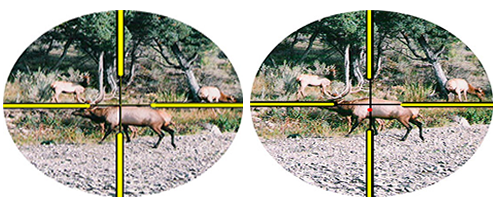
This old boy is farther out. In the picture on the left, his back-to-brisket line is about 3/4 of the way from the crosshair to bottom post. If he filled in only 1/2 that space, he would be 400 yards away. So, this sight picture shows he is about 300 yards from the shooter. If you knew from practice that your bullet will drop 8 inches from the point of aim at this distance, you need to hold about 10 inches below his back line. On this shot that would put the bullet 18 inches below the back line. Squeeze this one off, and you might just drop this guy in his tracks!
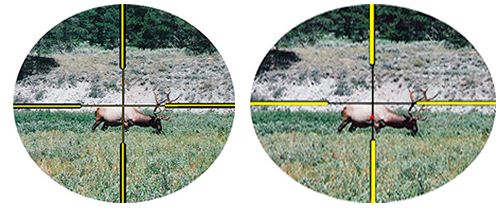
This bull’s body subtends one-half the space between the horizontal crosshair and the lower post. It’s distance from the end of your rifle barrel is… your right, 400 yards. Again, because of range practice, let’s say you know that your bullet will strike 19 inches lower than your aiming point at this range. Guess what, you’re already holding right where you need to for this range – squeeze that trigger and call your taxidermist!
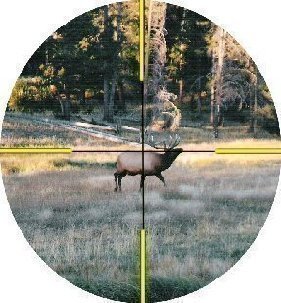
Are you going to shoot at this elk? In the sample scope that we have been using, the space that this fine animal subtends from backline-to-brisket is way less than a third of the space from crosshair to lower post which means this shot would be over 600 yards. Unless you have practiced and consistently been successful at this range, this shot would be way beyond your confidence zone. Save the “Hail Mary” shots for the NFL!
Now let’s take a look at a situation in which you would actually have to hold over the backline (off-hair) in order to take the shot. This time we are hunting an animal with a backline-brisket measurement of 18 inches. In this example, we are using a scope with a different sight picture than in the examples above (it has half the magnification power), so let’s go back to our ranging target for a moment.
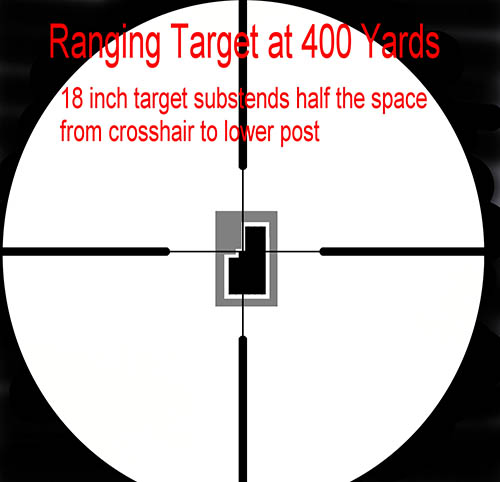
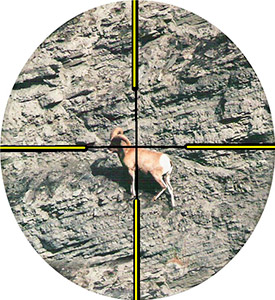
If the 18 inch ranging target subtends 1/2 the space from the crosshair to the lower post at 400 yards, this 18 inch ram, subtending the same space, would be 400 yards away. The pictures below show how to use the animal, itself, as part of the range-finding process. (This technique was used to determine the point-of-aim on the elk shots above.)

Here’s what the hunter should be “seeing” and thinking when he or she looks at the picture at the left. The ram measures 18 inches from backline to brisket, so the both the green lines would be 18 inches from the horizontal crosshair. That puts both green dots 9 inches from the crosshair. If we know from practice (there’s that word again) that the bullet will strike 19 inches lower than the aiming point at this range, the point of aim should be at the upper green dot. Take the shot on the right, and hope he doesn’t fall too far off that cliff!
Story by Chuck Tarinelli revised by CalSportsman


